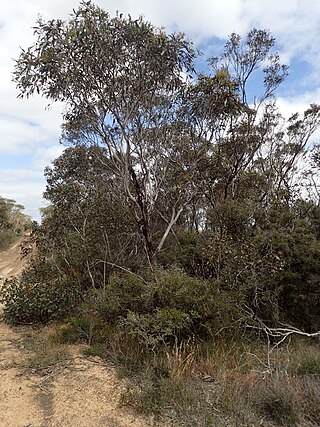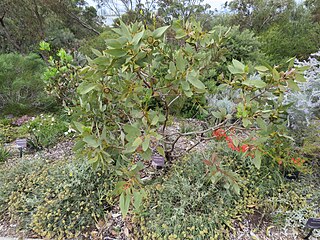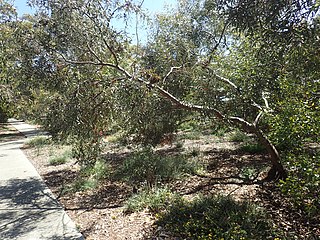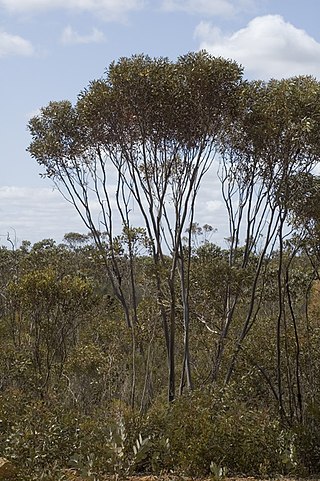Eucalyptus dolorosa, commonly known as the Mount Misery mallee or Dandaragan mallee, is a species of eucalypt that is endemic to Western Australia. It is a mallee with a short skirt of rough flaky bark at the base of the trunk, smooth pale greyish brown above, lance-shaped to curved adult leaves, flower buds in groups of seven, white flowers and cup-shaped to spherical fruit.
Eucalyptus crispata, commonly known as the Yandanooka mallee, is a species of tall mallee that is endemic to a small area on the east coast of Western Australia. It has a stocking of rough bark near the base of its trunk, smooth grey bark above, lance-shaped adult leaves, flower buds in groups of between nine and eleven, whitish to yellowish cream flowers and cup-shaped, barrel-shaped or hemispherical to cylindrical fruit.
Eucalyptus exigua is a species of mallee that is endemic to Western Australia. It has smooth, whitish bark, linear to narrow lance-shaped adult leaves, flower buds in groups of between seven and eleven, white flowers and short barrel-shaped to conical fruit.
Eucalyptus gypsophila, also known as the kopi mallee, is a species of mallee that is native to Western Australia and South Australia. It has rough, flaky bark on the lower part of the trunk, smooth light grey bark above, lance-shaped adult leaves, flower buds mostly in groups of between seven and eleven, creamy white flowers and conical to cylindrical fruit.

Eucalyptus hebetifolia is a species of mallee that is endemic to southern Western Australia. It has smooth grey and brownish bark with loose ribbons of bark near the base, lance-shaped adult leaves, flower buds in groups of up to thirteen, creamy white flowers and conical to barrel-shaped fruit.
Eucalyptus histophylla is a species of mallee or small tree that is endemic to southern Western Australia. It has smooth bark, often with ribbons of shed bark, linear to narrow lance-shaped adult leaves, flower buds arranged in groups in leaf axils, white flowers and cylindrical to barrel-shaped or conical fruit.

Eucalyptus impensa, commonly known as the Eneabba mallee, is a species of straggly mallee that is endemic to a small area of Western Australia. It has smooth bark, dull, light green, egg-shaped to broadly lance-shaped leaves, flower buds arranged singly in leaf axils, pink flowers and relatively large, flattened hemispherical fruit.

Eucalyptus incerata, commonly known as Mount Day mallee, is a species of mallee that is endemic to southern Western Australia. It has smooth bark, lance-shaped adult leaves, flower buds with a long, horn-shaped operculum and arranged in groups of seven, yellow flowers and barrel-shaped to cup-shaped fruit.

Eucalyptus lateritica, commonly known as laterite mallee, is a species of mallee that is endemic to a small area in the south-west of Western Australia. It has rough bark on the lower half of the trunk, smooth grey bark above, lance-shaped adult leaves, flower buds in groups of nine or eleven, white flowers and shortened spherical fruit.
Eucalyptus leprophloia, commonly known as scaly butt mallee, is a species of mallee that is endemic to a small area in Western Australia. It has rough, fibrous bark on the base of the trunk, smooth bark above, lance-shaped adult leaves, flower buds in groups of seven to eleven, white flowers and cup-shaped to barrel-shaped fruit.

Eucalyptus pluricaulis, commonly known as the purple-leaved mallee, is a species of mallee that is endemic to Western Australia. It has smooth bark, dull bluish green, lance-shaped leaves, flower buds in groups of between nine and fifteen, pale yellow flowers and cylindrical to barrel-shaped fruit.
Eucalyptus quadrans is a species of mallee or a small tree that is endemic to the southwest of Western Australia. It has smooth, greyish bark, narrow lance-shaped adult leaves, flower buds in groups of seven, white flowers and cup-shaped fruit that are square in cross-section.
Eucalyptus rigens, commonly known as saltlake mallee, is a species of sprawling mallee that is endemic to the southwest of Western Australia. It has smooth bark, lance-shaped adult leaves, flower buds in groups of three on a flattened peduncle and sessile, ribbed fruit.

Eucalyptus suberea, commonly known as Mount Lesueur mallee or cork mallee, is a species of mallee or a small tree that is endemic to a small area on the west coast of Western Australia. It has rough bark on some or all of the trunk, smooth white bark above, lance-shaped adult leaves, flower buds in groups of eleven to twenty or more, white flowers and shortened spherical fruit.
Eucalyptus thamnoides, also known as brown mallee, is a species of mallee that is endemic to south western Western Australia. It has smooth bark, lance-shaped adult leaves, flower buds in groups of seven, cream-coloured to pale yellow flowers and cup-shaped, conical or bell-shaped fruit.
Eucalyptus xanthonema, commonly known as yellow-flowered mallee, is a species of mallee that is endemic to the south west of Western Australia. It has smooth bark, linear adult leaves, flower buds in groups of up to eleven, white to pale lemon-coloured flowers and barrel-shaped fruit.

Eucalyptus captiosa is a species of mallee that is endemic to the south-west of Western Australia. It has smooth bark, lance-shaped adult leaves, groups of three or seven, slightly ribbed flower buds arranged in leaf axils, pale yellow flowers and cup shaped fruit.
Eucalyptus cuprea, commonly known as the mallee box, is a species of mallee that is endemic to the west coast of Western Australia. It has rough, flaky bark on the base of its trunk, smooth coppery-coloured bark above, lance-shaped adult leaves, flower buds in groups of seven, creamy white flowers and conical to cup-shaped fruit.

Eucalyptus diminuta, commonly known as the spring mallee, is a species of mallee that is endemic to south-west of Western Australia. It has smooth, silvery to greyish bark, sometimes with rough flaky bark near the base, lance-shaped adult leaves, pendulous, elongated flower buds arranged in groups of seven, creamy white flowers and cup-shaped to bell-shaped fruit.

Eucalyptus alatissima is a mallee that is endemic to central parts of the Great Victoria Desert. It has rough bark on the lower part of its stems, smooth tan to cream-coloured bark on its upper parts, egg-shaped to lance-shaped leaves and buds in groups of three. The buds have a powdery covering and are prominently winged.












